
The Canadian Northern Railway (CNoR) was a historic Canadian transcontinental railway. At its 1923 merger into the Canadian National Railway, the CNoR owned a main line between Quebec City and Vancouver via Ottawa, Winnipeg, and Edmonton.
The Southern Alberta Institute of Technology (SAIT) is a polytechnic institute in Calgary, Alberta, Canada. SAIT offers more than 110 career programs in technology, trades and business. Established in 1916, it is Calgary's second oldest post-secondary institution and Canada's first publicly funded technical institute.
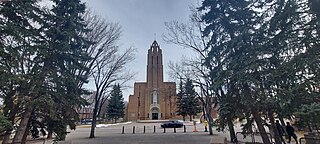
St. Mary's Cathedral in Calgary, Alberta, Canada is a Roman Catholic cathedral and the seat of the Diocese of Calgary. The building's full name is The Cathedral of the Immaculate Conception of the Blessed Virgin Mary.

Broughton Gifford is a village and civil parish about 1.5 miles (2.4 km) west of Melksham in Wiltshire, England. The parish includes the hamlets of Norrington Common and The Common.
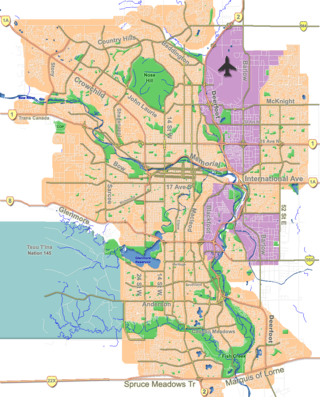
Kensington is a Business Revitalization Zone (BRZ) in Calgary, Alberta, focused around the intersection of Kensington Road and 10th St. NW, also known as the Kensington-Louise Crossing Business Association. It is located in the communities of Hillhurst and Sunnyside, immediately north of downtown and the Bow River, and is easily reached by most of the city's major access routes.

The Fairmont Palliser, formerly known as the Palliser Hotel, is a hotel of the Canada-based Fairmont Hotels and Resorts chain. The historic hotel (1914) is located in downtown Calgary, Alberta, at 133 9 Avenue SW adjacent to the Calgary Tower and Palliser Square. The Palliser is one of Calgary's oldest and most luxurious hotels.
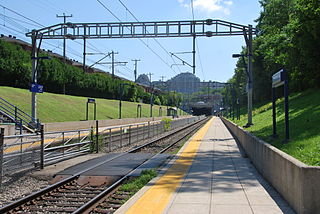
The Mount Royal Tunnel is a railway tunnel in Montreal, Quebec, Canada. The tunnel is the third longest in Canada, after the Mount Macdonald Tunnel and the Connaught Tunnel, and connects the city's Central Station, in Downtown Montreal, with the north side of Montreal Island and Laval and passes through Mount Royal.

Downtown Calgary is a dense urban district in central Calgary, Alberta. It contains the second largest concentration of head offices in Canada, despite only being the country's fourth largest city in terms of population. The downtown is divided into several residential, commercial, corporate, and mixed-use neighbourhoods, including the Financial District (CBD), Eau Claire, Chinatown, East Village, Beltline, and the West End.

Balcombe is a village and civil parish in the Mid Sussex District of West Sussex, England. It lies 31 miles (50 km) south of London, 16 miles (26 km) north of Brighton, and 32 miles (51 km) east-northeast of the county town of Chichester. Nearby towns include Crawley to the northwest and Haywards Heath to the south-southeast.

Codford is a civil parish south of Salisbury Plain in the Wylye Valley in Wiltshire, England. Its settlements are the adjacent villages of Codford St Peter and Codford St Mary, which lie some 7 miles (11 km) southeast of Warminster.
Glenbow is a locality in southern Alberta, in Rocky View County located northwest of the City of Calgary and east of the Town of Cochrane on Highway 1A. It is now part of the Glenbow Ranch Provincial Park. The Glenbow area is immediately west of Rocky View County's Bearspaw area.
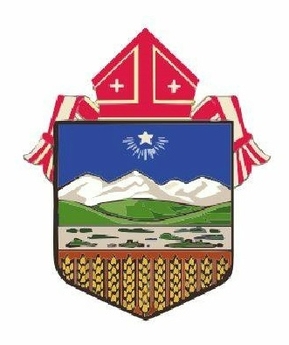
The Diocese of Calgary is a Latin Church ecclesiastical territory or diocese of the Catholic Church in Alberta, Canada. The Diocese of Calgary is a suffragan diocese of the metropolitan Archdiocese of Edmonton.

The CN Tower is an 111-metre-tall (364 ft), 26-storey office building located in Edmonton, Alberta, Canada. The building was built by the Canadian National Railway Company as Edmonton's first skyscraper, and at its completion in 1966 was the tallest building in Western Canada. The CN Tower would remain Edmonton's and Western Canada's tallest building until 1971 when it was surpassed by Edmonton House.
The Old Canadian National rail yard in Edmonton was once the centre of economic activity in that city. Its redevelopment has fundamentally altered the appearance of the city. The former yard occupied a long, narrow strip from 103 Avenue to 105 Avenue north to south and from 101 Street to 116 Street east and west.

The Calgary Folk Music Festival is a Canadian music festival held on the fourth weekend of July each year at Prince's Island Park, Calgary, Alberta. The four-day event features 70 artists from over 15 countries, who perform for an audience of over 52,000 people across multiple stages.
This is a timeline of the history of Calgary, Alberta, Canada..
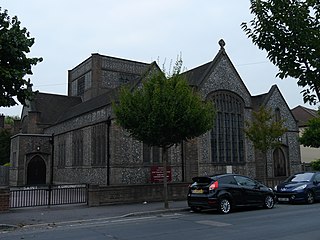
The Church of St Edmund, Chingford, is a Grade II listed Church of England parish church at Larkswood Road, Chingford, in Greater London.
Edmonton was the terminal station for passenger services along the Canadian Pacific Railway's subdivisions from Calgary to Edmonton shortly after the completion of the High Level Bridge, with services commencing on September 2, 1913. Passenger services across the North Saskatchewan River were discontinued in 1972, and the station building itself was demolished in 1978.

Martinhoe is a small settlement and civil parish in North Devon district of Devon, England. Martinhoe is within the Exmoor National Park, the smallest National Park in England. In the 2011 census Martinhoe Parish was recorded as having a population of 159. Martinhoe is in the Combe Martin ward, for elections to the district council. Martinhoe's local government takes the form of a parish meeting and as such has no parish council nor elected parish councillors.

St Andrew's Church was a Church of England church on Barking Road in Plaistow, east London. It began as a small mission built in 1860 on Whitwell Road by St Mary's Church, Plaistow. A permanent church designed by James Brooks opened in 1870 on a site just south of the northern outfall sewer embankment and a separate parish assigned to it the following year. A large central crossing tower with a pyramidal spire was planned but only completed as far as the ridge of the nave roof.
















